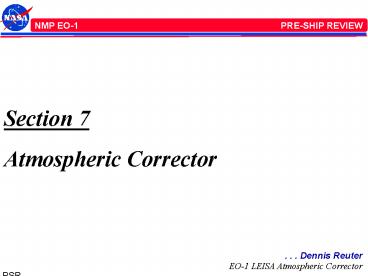PSR Section 7 PowerPoint PPT Presentation
1 / 13
Title: PSR Section 7
1
Section 7 Atmospheric Corrector
. . . Dennis Reuter EO-1 LEISA Atmospheric
Corrector
2
LEISA Atmospheric Corrector (LAC) Contribution to
EO-1
- Validation of Wedged Filter Approach for
Spacecraft Instrumentation - Atmospheric correction for ALI Multispectral
images - Atmospheric correction for Landsat-7 images
(Formation Flying) - Direct study of Spatial Resolution Degradation
(cross-comparison with Hyperion) - Retrieved atmospheric parameters
- Cross-comparison with MODIS
3
LAC BLOCK DIAGRAM
28 V
Lenses
power
Power Conversion
digital
RS 422
Digital Buffers and
Formatting
SPACECRAFT
bias
1773
1773 Interface, Array
Control and TEC Control
clock
TEC
ELECTRONICS
l
MODULE
3 Wedged Filter/ Array Assemblies
OPTICS MODULE
4
LAC Characteristics
- High Spectral - Moderate Spatial Resolution
Hyperspectral Imager using Wedged Filter
Technology (LVE). - Spectral Coverage 0.9 - 1.6 mm 256 Bands
Selected for optimal correction of High Spatial
Resolution Images. - Spectral Resolution 35 cm-1 (Dl 3 nm _at_ 0.9 mm,
9 nm _at_ 1.6 mm) - Swath Width 185 km Matches Landsat.
- Spatial Resolution (pixel) 356 mradian (250
meter _at_ 705 Km). - Three 256 x 256 Element InGaAs Arrays TEC
Stabilized (lt285 K). - Three 15 Degree FOV 3 Element Lenses.
- Two Modules Bolt-onOptics Module and
Electronics Module. - Mass 10.5 kg (EM, 4.4 kg OM 3.9 kg Cable 2.2
kg). - Power 48 W (Peak) lt15 W (Orbital Average).
5
Performance Testing
- Box Level
- Cards Simulated on an Individual Basis
- TECs Tested with Engineering Backplane (Focal
Plane) - Focal Plane Timing Tested with Multiplexers
- Subsystem Level
- OM Limited Set of Images Obtained with EM
Simulator - Engineering Model Vibration Tested
- EM Operation Tested by Interface to OM Simulator
- Instrument Level
- Vibration and Thermal-Vacuum
- Radiometric, Spectral Calibration and Alignment
- EMI/EMC
6
LAC Test Descriptions
- Vibration
- Individual modules tested to proto-flight level
(1.25 x expected maximum flight loads) - Instrument mounted on Spacecraft and tested to
flight level - Thermal Vacuum (Pre-Spacecraft Integration)
- Four cycles to survival levels (-10C to 50C
Range expected on orbit 20C? 10C) - Operation from 0C to 30C (Orbital Predict
20C, 30C worst case) - Images Obtained Using LAC GSE
- Thermal Vacuum (Integrated with Spacecraft)
- Four Cycles
- Operation from 0 C to 30 C (No Operation at 40
C) - Images Using Spacecraft System (WARP, XBPAA,
etc.)
7
LAC Test Descriptions
- EMI/EMC
- Instrument Level Tests Conducted and Radiated
Emissions, and Radiated Susceptibility - Alignment
- Orientation of Arrays with respect to Alignment
Cube using Theodolites - LAC Alignment to ALI on Spacecraft Using
Theodolites - Optical Calibration
- Wavelength and Instrumental Shape Grating
Monochrometer 1 to 100 nm Steps - Radiometric Calibrated Black-body (all 4 TEC
Settings) - Flat Field Diffuse Source Illuminating Lenses
and Solar Calibrators
8
LAC Test Results / Actions
- Vibration (Proto-flight, Module Level)
- OM Arrays contacted by LVE some damage to
arrays and LVEs wire bonds broken on one array - Incorrect assembly of LVE mount
- Wire bonds repaired on array
- One LVE replaced with flight spare
- LVE mount re-assembled correctly
- Module re-vibrated with no damage
- EM 1773 Fiber Alignment Cylinder Cracked
- Failure mode observed in other 1773 interface
applications - Cylinder replaced
- Module re-tested with no damage
- Vibration (Satellite, Instrument Level) No
damage
9
LAC Test Results /Actions
- EMI/EMC
- Excessive radiated / conducted Emissions (20 - 30
dB in some places) - Interpoint Power Supply filtering
- Additional Filter Assembly mounted on EM
- Filter reduces excess emissions to at most 5 dB -
waiver granted - Components destroyed during conducted
Susceptibility Test - Incorrect test conditions
- Components replaced
- Test was not repeated - waiver granted
10
LAC Test Results /Actions
- Thermal Vacuum (before Spacecraft integration)
- Instrument operated for approximately 10 hours
- Mount temperatures lt 25 C, continuous operation
for 1 hour - Mount temperature 30 C, Digital Board overheated
in 40 minutes - No modification Maximum operating time in-flight
20 minutes - Thermal Vacuum (Spacecraft)
- Instrument operated for approximately 20 hours
- Dark current consistent with previous results
- Mount 40 C Power Board reached Red-Limit temp
in lt 5 minutes - Power board Red-Limit set for mount temperature
at lt 30 C Models indicate Red-Limit can be
increased 20 C - Excellent TEC control
11
LAC Test Results /Actions
- Optical Calibration
- Radiometric
- Initial results consistent with models
- Offset error limits dynamic range to 11 bits.
Difficult to differentiate High Albedo from
Specular Reflection - Unexpected temperature dependence of Quantum
Efficiency - Spectral
- Filters have excellent spectral characteristics
- Alignment Within 2 arc-min of ALI Track --
achieved 1 - Flat Field Solar Calibrators consistent with
Diffuse Illumination
12
Modifications
- Software
- Red-Limits on currents eliminated
- TEC set-points lowered to reflect improved
thermal results on Spacecraft - Hardware
- No additional hardware modifications required
- NO SIGNIFICANT OPEN ISSUES INSTRUMENT HAS RUN
SEVERAL HUNDRED HOURS 50 TROUBLE-FREE - REQUIRED ORBITAL OPERATION 50 HOURS
13
Waivers and NCRs
- 5 waivers
- 3 EMI / EMC
- Parts tracability
- Degraded performance of TEC 3 during instrument
T/V - Not apparent in Spacecraft T/V tests
- 9 NCRs
- Waivers and NCRs available in GSFC system

